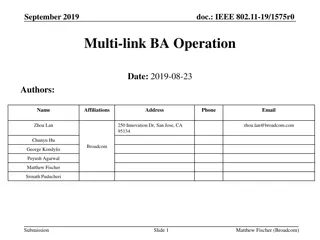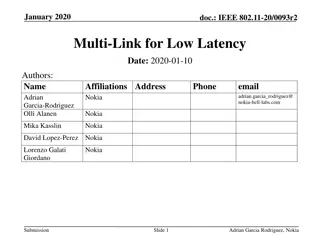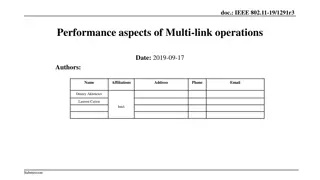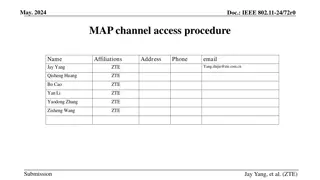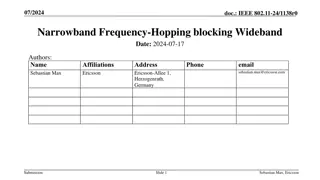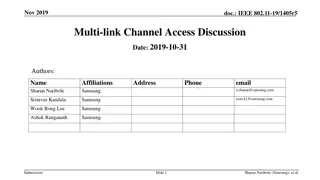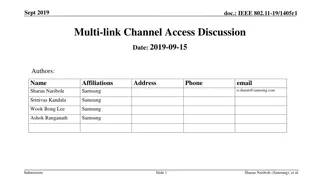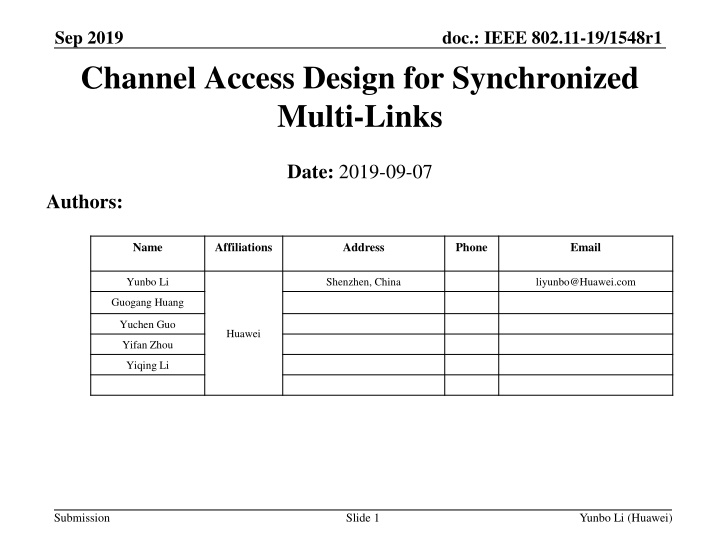
Channel Access Design for Synchronized Multi-Links in IEEE 802.11-19
Explore the design considerations for synchronized multi-links in IEEE 802.11-19, covering topics such as TXOP setup, primary sub-channels, and bandwidth negotiation. Understand the complexities and solutions for channel access in synchronized multi-link environments.
Download Presentation

Please find below an Image/Link to download the presentation.
The content on the website is provided AS IS for your information and personal use only. It may not be sold, licensed, or shared on other websites without obtaining consent from the author. If you encounter any issues during the download, it is possible that the publisher has removed the file from their server.
You are allowed to download the files provided on this website for personal or commercial use, subject to the condition that they are used lawfully. All files are the property of their respective owners.
The content on the website is provided AS IS for your information and personal use only. It may not be sold, licensed, or shared on other websites without obtaining consent from the author.
E N D
Presentation Transcript
doc.: IEEE 802.11-19/1548r1 Sep 2019 Channel Access Design for Synchronized Multi-Links Date: 2019-09-07 Authors: Name Affiliations Address Phone Email Yunbo Li Shenzhen, China liyunbo@Huawei.com Guogang Huang Yuchen Guo Huawei Yifan Zhou Yiqing Li Submission Slide 1 Yunbo Li (Huawei)
doc.: IEEE 802.11-19/1548r1 Sep 2019 Introduction There are two types of multi-links (ML) base on the capability of simultaneous TX/RX on different links Synchronized ML Asynchronized ML Q-async or similar concept is mentioned in other presentations. The concept is more complex, for simplicity we didn t discuss it here; The channel access in asynchronized MLs could be independent, it is simple to design; The transmissions in multiple links are need to be synchronized in synchronized MLs, and many issues need to be considered for channel access; All the following slides are discussed for synchronized ML. Submission Slide 2 Yunbo Li (Huawei)
doc.: IEEE 802.11-19/1548r1 Sep 2019 TXOP setup A ML device transmits TXOP initial frames (e.g. RTS) on the links that are idle at the time when backoff is finished; It doesn t touch the channel access details. E.g. single primary channel or multiple primary channels; and how to backoff. TXOP could only be set up on the links that successfully get response frames (e.g. CTS) when the responses are needed; In below example, RTS send on 3 links, but TXOP only set up successfully on link1 and 4. Backoff finished TXOP RTS CTS Data BA Data Link 1 RTS Link 2 Link 3 Busy Link 4 RTS CTS Data BA Data Submission Slide 3 Yunbo Li (Huawei)
doc.: IEEE 802.11-19/1548r1 Sep 2019 TXOP setup Different TXOP initial frames may be sent on different links; The end times of initial data should be aligned if responses are needed. TXOP Backoff finished RTS CTS Data BA Data Link 1 RTS Link 2 CTS to Self Data BA Data Link 3 OR Data (ACK) Link 4 BA Data BA Data Data (ACK) Link 5 Data BA Data Data (No ACK) Link 6 Link 7 Submission Slide 4 Yunbo Li (Huawei)
doc.: IEEE 802.11-19/1548r1 Sep 2019 Primary 20MHz sub-channel and BW on each link No matter single primary channel, or multiple primary channels for ML, each link may has a primary 20MHz sub-channel; It will be convenient to support dynamic bandwidth negotiation, otherwise receiver side will needs multiple decoder in each link TXOP bandwidth on each link is base on bandwidth negotiation on its own link; TXOP RTS RTS Link 1 CTS Data BA RTS Data P 20MHz RTS CTS Link 2 RTS P 20MHz RTS CTS Data BA Data Submission Slide 5 Yunbo Li (Huawei)
doc.: IEEE 802.11-19/1548r1 Sep 2019 Problem Statement Example: Non-AP ML device (MLD)1 only obtains link 1 after backoff finished, and transmits PPDU 1 to AP MLD; Later, non-AP MLD 2 sends PPDU2 on link 2 to the same AP MLD during the transmission period of PPDU1; AP MLD can not replies BA for PPDU 1 in link 1 in this case A simple solution is single primary channel for synchronized ML, which we more preferred; For multiple primary channels in synchronized ML, several solutions are shared for discussion in following slides. ? PPDU 1 BA Link 1 Busy PPDU 2 Link 2 Non-AP MLD 1 Non-AP MLD 2 AP MLD Submission Slide 6 Yunbo Li (Huawei)
doc.: IEEE 802.11-19/1548r1 Sep 2019 Intra BSS solution 1 When non-AP MLD2 receives PPDU 1 on link 1 and identifies it as an intra-BSS PPDU, the non-AP MLE2 defers EDCA contention on link 2 after the TXOP set by PPDU 1; TXOP PPDU 1 BA Link 1 AIFS PPDU 2 Link 2 Non-AP MLD 1 Non-AP MLD 2 AP MLD Submission Slide 7 Yunbo Li (Huawei)
doc.: IEEE 802.11-19/1548r1 Sep 2019 Intra BSS solution 2 When non-AP MLD2 receives PPDU11 and identifies it as an intra- BSS PPDU, the non-AP MLD2 immediately start EDCA contention on link 2. When transmits PPDU21 on link2, its end time should be aligned with the end time of PPDU11; Non-AP MLD2 doesn t know the end time of PPDU12, so it needs to first decode the preamble of PPDU12 to get the PPDU length, and then aligns the end times of PPDU22 and PPDU12. TXOP BA PPDU 11 BA PPDU 12 Link 1 AIFS PPDU 22 BA PPDU 21 BA Link 2 Non-AP MLD 1 Non-AP MLD 2 AP MLD Submission Slide 8 Yunbo Li (Huawei)
doc.: IEEE 802.11-19/1548r1 Sep 2019 Inter BSS solution When non-AP MLD2 receives PPDU 1 and identifies it as an inter- BSS PPDU, the non-AP MLD2 starts EDCA contention immediately; The time that identifies PPDU1 as an inter-BSS PPDU could be The end time of PHY preamble of PPDU1, or The end time of first MPDU in PPDU1, or; others. Pre- amble PPDU 1 BA Link 1 AIFS PPDU 2 Link 2 Non-AP MLD 1 Non-AP MLD 2 AP MLD Submission Slide 9 Yunbo Li (Huawei)
doc.: IEEE 802.11-19/1548r1 Sep 2019 Summary Some rules for TXOP setup in synchronized ML are discussed; One problem of multi-link transmission is showed, and several potential solutions are prepared for discussion. Submission Slide 10 Yunbo Li (Huawei)
doc.: IEEE 802.11-19/1548r1 Sep 2019 Straw Poll 1 Do you agree that there is a primary 20MHz sub-channel in each link of synchronized multiple links to support dynamic bandwidth negotiation? Note: There is a primary 20MHz sub-channel in each link doesn t imply multiple primary channels in channel access. Yes No Abstain Submission Slide 11 Yunbo Li (Huawei)






